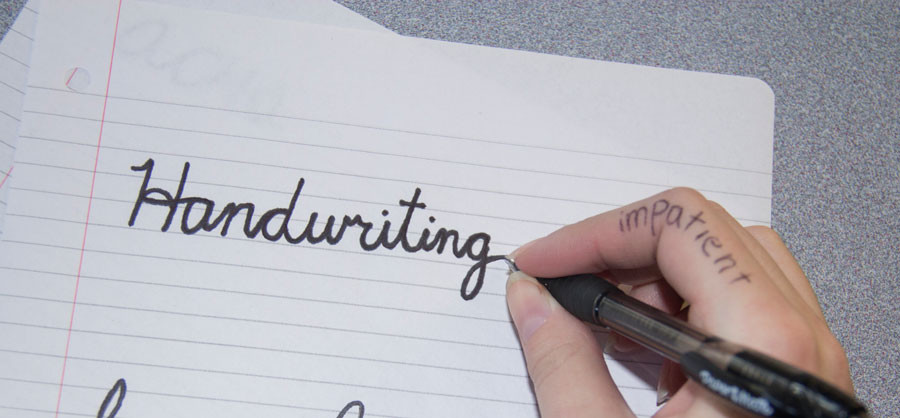Loops, Dots and Crosses
One’s handwriting may be the key to understanding someone’s lies, confidence, childishness and more.
Everyday, students write thousands of words in their own personal style of handwriting. A person’s handwriting can vary from large to small, leaning left or leaning right, big loops to closed loops and so much more. All of these varying qualities mean something different to graphologists, or people who analyze handwriting. Just from the looks of how one sentence is written, a graphologist can tell a lot about a someone’s personality. But in order for graphologists to understand personalities within handwriting, the writer must use cursive instead of print. The way in which one writes is a form of communication; it can tell others, nonverbally, the type of person someone really is.
Size
When it comes to handwriting, size does matter. People with larger handwriting tend to be very outgoing, people-oriented and outspoken. They love attention and the limelight. Unsurprisingly, celebrities tend to have large handwriting. On the contrary, those with smaller handwriting are shy or withdrawn, but are more studious, concentrated and meticulous. Finally, medium-sized handwriters are well-adjusted and very adaptable.
Spacing Between Words
When writing, a space needs to be in between each different word. Wide spacing means that the person enjoys their freedom and does not like to be overwhelmed or crowded. On the contrary, narrow spacing implies that the person does not like to be alone and they tend to crowd others or be intrusive.
Loops of L’s and E’s
Lower case “l” and “e” both have loops when written in cursive. L loops have more to do with how the person is feeling at the moment rather than their constant personality. A narrow L loop can imply that the person is restricting themselves and may lead to feelings of tension. Wide L loops imply that the person is relaxed. If someone constantly writes wide loops, one can assume they are spontaneous and that self-expression comes easily to them. E loops are more about personality. A narrow E loop means the person is skeptical of others, but they tend not to be swayed by the emotions of others. Wide E loops make for an open minded person who enjoys trying and experiencing new things.
Dotting Your i’s
For the lower case “i” in cursive and print handwriting, a dot goes over the short bottom line. A dot very high over the “i” means that a person has a great imagination, while just having a slash over the “i” means the person is overly self-critical and impatient. If the dot falls a little to the left, this person is a procrastinator. People with dots that fall perfectly above the “i” are very detail-oriented and empathetic. If someone circles their dots this means they are visionary and child-like.
Crossing T’s
Whether the letter “t” is uppercase or lowercase, it has a cross through it. If someone crosses the very top this means they are ambitious, optimistic and have good self-esteem. Long crosses show determination and enthusiasm, but also stubbornness. People who cross right in middle are confident and feel comfortable in their own skin. Only lazy people with a lack of determination have short crosses.
S’s
Just like e’s and l’s, just one letter like s can say a lot about someone’s personality. In cursive, a round s means the person is a people pleaser and avoids confrontation. Those who write a pointy s enjoy learning new things and are inquisitive and ambitious. The higher and pointer the peaks, the more ambitious the person is. One who writes a wide bottom s might not be following their heart.
Pressure and Speed
The pressure and speed you use when writing can say something about personality and health. Those who write heavy are good with commitments and taking things seriously. Health wise, they have high energy and, in general, better health. But, if someone writes excessively heavy, this means they are uptight and react quickly to criticism. Light writers tend to be more sensitive and empathetic and lack energy. They are more likely to have health problems. Speedy writers are impatient and dislike delays and time wasters, while slow writers are organized and self-reliant. Slower writers are generally healthy people.
Signature
Many people compare sloppy signatures to doctors, but this is with good reason. People with messy signatures are very private and hard to read or understand, but they are highly intelligent. Legible signatures are made by people who are confident and comfortable in own skin and are genuine people.
Slant
Slanting when writing is not seen in just one or two words, but in everything someone writes. Just looking at a few sentences, someone can tell immediately whether a person’s handwriting slants left, right or not at all. No slant means the person does not let their emotions get the best of them. This is because the person is most likely logical and practical. If someone slants right, they are open to new experiences and like meeting new people. Someone who slants left likes to keep to themselves and work behind the scenes. If someone is right handed and their handwriting slants to the left they may be expressing rebellion.
Page Margins
People have a tendency to both slant one way and write closer towards one margin. Those that write closer to the left margin live in the past and have a hard time letting go of things. In contrast, writing closer to the right margin means the person fears the unknown and constantly worries about the future. If someone just writes all over, it means they can’t sit still or relax and their mind is constantly running.
Liar, liar
Someone is probably lying about what they are writing if their handwriting is bunched up, moved out of alignment from the other writing or is in any way different from how they normally write.
There are so many more forms and techniques of writing graphologists can look at and decipher, which makes handwriting an underappreciated form of communication. The next time you want to learn something about a stranger, just look at their handwriting. The results and their accuracy just might surprise you.



